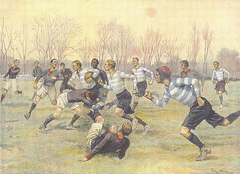Let’s talk about Headgear. It’s been around for some 7

0 years, gaining popularity with the efforts by Cliff Keen. Headgear is required in high school and collegiate wrestling competition , but is optional in Canada and international pro
grams including Greco-Roman and Freestyle (ear trauma). Moreover, it’s not usually worn in practice (ear trauma) and can actually create ear damage if worn improperly (more ear trauma)
Headgear in Jiu Jitsu? Not usually seen in most academies, and all the organizations/federations won’t allow it during competition (ear trauma)
Rugby and the scrum cap. First known use of a cap is speculated around 1890, as one is pictured in the first championship in France.
Developed for forwards, they are now used by any position for protecting the ear. As a substitute, a piece of foam or cloth is used along with electrical tape.
Only recently have I seen rugby athletes wearing scrum caps, and it’s only a few on any given team (ear trauma)
THE PROBLEM I HEAR OVER AND OVER IS HOW UNCOMFORTABLE WEARING EAR PROTECTION ACTUALLY IS.
As the owner of a couple nubs on my own ear, what surprises me the most, is how uneducated the medical world is in dealing with it confidently, effectively and affordably.
Of course there are medical doctors, EENT’s and other practitioners that can treat the precursor to Cauliflower Ear (the auricular hematoma), but not very many to be honest.
During my first bout with ear damage, I had a heck of a time finding a medical doctor who would even agree to touch it, literally. They sent me to the ER, where I was looked at as if I had done something wrong having a large sack of fluid sitting at the top of my left ear. They drained it, wrapped gauss around my head and sent me on my way. Post drain, it was full of fluid within 12-24 hours. I started draining the thing daily until it became a part of my permanence.
Note: Finding a medical option to treat an ear filled with blood, doesn’t mean the outcome is going to be positive.
I do remember the second time my ear received similar damage by way of a triangle in BJJ, and from there I spent 2 years figuring out how to hold steady compression on my ear for 4-7 days, and thought that if I could compress it before it fills, I would be spending more time on the mats and less time running around looking for solutions with a throbbing ear. Kind of amazing to think about how painful this condition can be, and realize it’s been happening for thousands of years.

In the process of developing and improving the Caulicure product, I have seen the whole gamut of options out there to treat the ear damage, but very little on improving the prevention side. This is not to say that headgear and scrum caps don’t prevent Cauliflower Ear, they do, but they must be worn in order to be effective.
It’s an eye opener to think about how little knowledge there is, smack dab, right in the middle of contact sport, as to what the F~%* to do about it once it appears.
We have photo after photo of ears that were treated with poor outcomes, for a condition that in all seriousness, SHOULDN’T BE A MAJOR ISSUE TO PREVENT AND HEAL COMPLETELY.
Effective compression before Cauliflower Ear develops is only now surfacing with options that can truly prevent as opposed to treat. We have taken this a step further, by allowing compression On and Off the Mats and “soon” On and Off the Field.
Three things to consider when looking at how to address the issue.
- 1. If you have a system that can provide compression before the ear has a chance to fill, you’re golden.
- 2. If you can keep that compression in place while you continue to play or train in your sport, you have come that much closer to solving the dilemma.
- 3. If you’re prepared and have the right equipment at a moments notice, ear damage becomes an issue you might just be able to handle on your own.
Our next topic will be centered around what really happens to most athletes who get caught with “AN EAR FULL”


1894 comments
FEKOjtpoqHVUC
BjNMhauiFmPdU
oaJnpVjeSsrOI
NYHsnuWI
DqLYvZgrSpzFUa